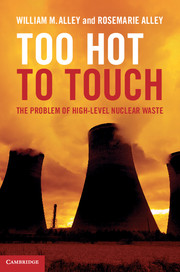Book contents
- Frontmatter
- Contents
- Acknowledgments
- List of units
- List of abbreviations
- Introduction
- Part I The problem
- 1 The awakening
- 2 Brainstorming
- 3 The ocean as a dumping ground
- 4 Radioactivity and atomic energy
- 5 The Cold War legacy
- 6 The peaceful atom and its wastes
- 7 Recycling
- 8 Dry cask storage
- 9 Interim storage
- 10 A can of worms
- 11 WIPP
- Part II The mountain
- Part III No solution in sight
- Appendix Discussion questions
- References
- Index
3 - The ocean as a dumping ground
from Part I - The problem
Published online by Cambridge University Press: 05 February 2013
- Frontmatter
- Contents
- Acknowledgments
- List of units
- List of abbreviations
- Introduction
- Part I The problem
- 1 The awakening
- 2 Brainstorming
- 3 The ocean as a dumping ground
- 4 Radioactivity and atomic energy
- 5 The Cold War legacy
- 6 The peaceful atom and its wastes
- 7 Recycling
- 8 Dry cask storage
- 9 Interim storage
- 10 A can of worms
- 11 WIPP
- Part II The mountain
- Part III No solution in sight
- Appendix Discussion questions
- References
- Index
Summary
Roll on, thou deep and dark blue Ocean – roll!
Ten thousand fleets sweep over thee in vain;
Man marks the earth with ruin – his control
Stops with the shore
Lord ByronIn the early days of atomic energy, the oceans were viewed as a convenient place for getting rid of all kinds of radioactive waste. The volume of water is huge and dilution would quickly reduce concentrations to minuscule levels. There was a catch, though. Toxic materials can be ingested by microorganisms and concentrated as they are passed up the food chain to higher organisms, including human beings. Moreover, ocean circulation can carry waste over large distances in short times.
Any doubts about the potential for long-distance transport of waste, particularly in the ocean’s surface, should be dispelled by the studies of Dr. Charles Ebbesmeyer, a retired oceanographer living in Seattle. Ebbesmeyer originally monitored ocean currents by tracking buoys and markers dropped at sea.When his mother heard about 80,000 Nike shoes floating at sea in 1990, she brought it to her son’s attention. Thus began Ebbesmeyer’s second career, tracking objects accidentally spilled at sea using a worldwide network of enthusiastic beachcombers. In 1992, Ebbesmeyer and his network began to track 29,000 bathtub toys washed overboard from a container ship during a storm in the eastern Pacific. Adrift on the open sea, many of the castaways floated south where some beached on the far-flung coasts of Australia, Indonesia, and western South America. An armada of about 10,000 rubber ducks, beavers, turtles, and frogs headed north toward Canada and Alaska, propelled by wind and sea. Some circled back to Japan. Others got caught in the Arctic and hitched their way eastward with the floating ice. By 2000, some of those caught in the Arctic ice had reached the North Atlantic, where they were freed from the thawing ice. In 2003, after an epic 11-year journey halfway around the world, a rubber duck was found in Maine and a rubber frog in Scotland.
- Type
- Chapter
- Information
- Too Hot to TouchThe Problem of High-Level Nuclear Waste, pp. 29 - 45Publisher: Cambridge University PressPrint publication year: 2012



